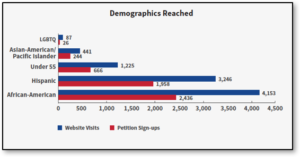by Sarah Pettit
Digital advertising isn’t just for big-name corporate sales anymore. It offers nonprofits and advocacy groups enormous potential for mobilizing the most effective supporters in the right places. But success demands a highly targeted strategy for recruiting advocates where it counts.
At Reingold, I work with a team of digital analysts, graphic designers, and copy writers who recently produced a winning digital advertising campaign — Cancer Votes — for the American Cancer Society Cancer Action Network. In just three months, we created and continuously optimized ads that enlisted 39,349 new advocates within specific minority populations in targeted states and congressional districts — where their voices could have the greatest impact.
ACS CAN identifies and rallies advocates to press their congressional representatives for cancer research funding and support. During the 2016 election cycle, the Cancer Votes campaign took advantage of heightened political interest to raise awareness and build the organization’s database of support, calling on members of target audiences to sign an online Cancer Votes petition.
So what does it take for digital advertising to drive action and impact? My team recommends these three steps:
- Define your target audience. With your end goal in mind, consider gaps in your support base to target the demographic groups and geographic areas where you want to gain traction.
Cancer Votes aims to persuade select policymakers to support cancer research funding while also building a more diverse base of support. So the Cancer Votes campaign’s target audiences included African-Americans, Asian-Americans, Hispanics, the LGBTQ community, and younger voters who live in key battleground states and congressional districts. Using Facebook’s sophisticated targeting capabilities, my team directed campaign ads to these demographic groups in geotargeted areas and drove them to the campaign webpage. Remarkably, 58.2 percent of those who visited the site signed the Cancer Votes petition to join the ranks of ACS CAN advocates.

ACS-CAN Demographics Reached
- Create and test ad content. Effective campaigns need messages that speak to a specific audience and deliver a strong call to action — like “Sign the petition” — to produce a measurable result. Through testing variations of ads, you can figure out which messages and images achieve the greatest response.
Reingold created ad copy asking audiences to call on their congressional candidates to support cancer research, achieving the highest numbers of clicks to the campaign webpage and petition sign-ups. Over time, we prioritized these messages and created new iterations of the ads with the winning text. Our designers featured images of adult cancer patients and scenes with patriotic themes, which achieved comparable results.
- Reach your audiences where they are. Measure and optimize ad placements that generate results — and drop those that don’t. Track and compare how ads are performing across platforms like desktop news feeds, mobile news feeds, and right rails.
Reingold’s digital advertising team tested and maximized campaign results through constant monitoring. Ads on desktop news feeds and mobile news feeds performed best, generating the largest number of website visits and petition sign-ups at the lowest cost. So we shifted spending to these platforms and kept refreshing the ad content to keep audiences engaged.
“Digital advertising is a great way to recruit people to get involved in an advocacy group’s mission,” says Reingold Vice President Joseph LaMountain. “Not only do advocates advance the organization’s mission through political action, but many of those supporters become long-term donors and volunteers.” Our Cancer Votes campaign successfully recruited advocates in areas that matter the most.
 Sarah Pettitt is a communications associate at Reingold, a full-service strategic communications firm. She specializes in research, content creation, strategic communications, and campaign planning. Sarah works with nonprofit and advocacy organizations and with federal agencies, spanning the education, health care, and natural sciences sectors. Sarah has a master’s in public relations and corporate communications from Georgetown University. Connect with her on LinkedIn.
Sarah Pettitt is a communications associate at Reingold, a full-service strategic communications firm. She specializes in research, content creation, strategic communications, and campaign planning. Sarah works with nonprofit and advocacy organizations and with federal agencies, spanning the education, health care, and natural sciences sectors. Sarah has a master’s in public relations and corporate communications from Georgetown University. Connect with her on LinkedIn.



